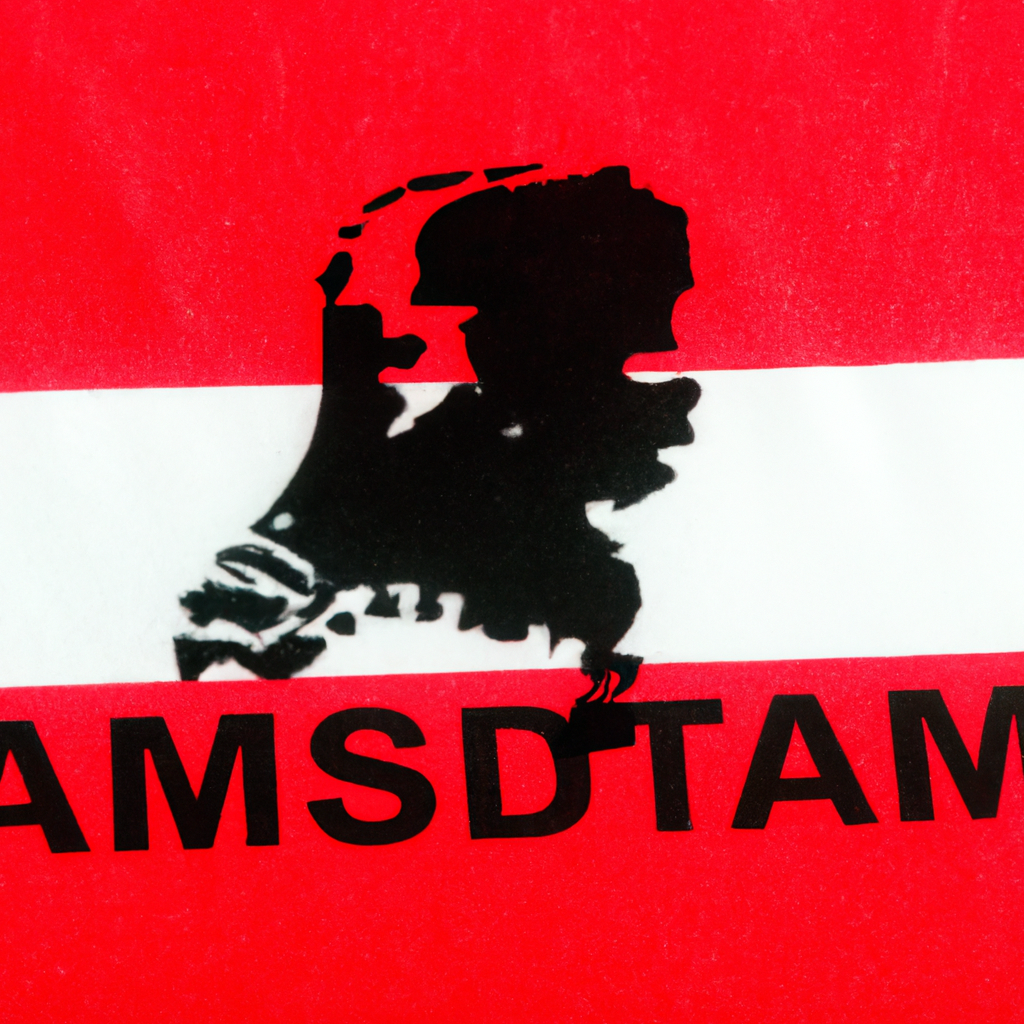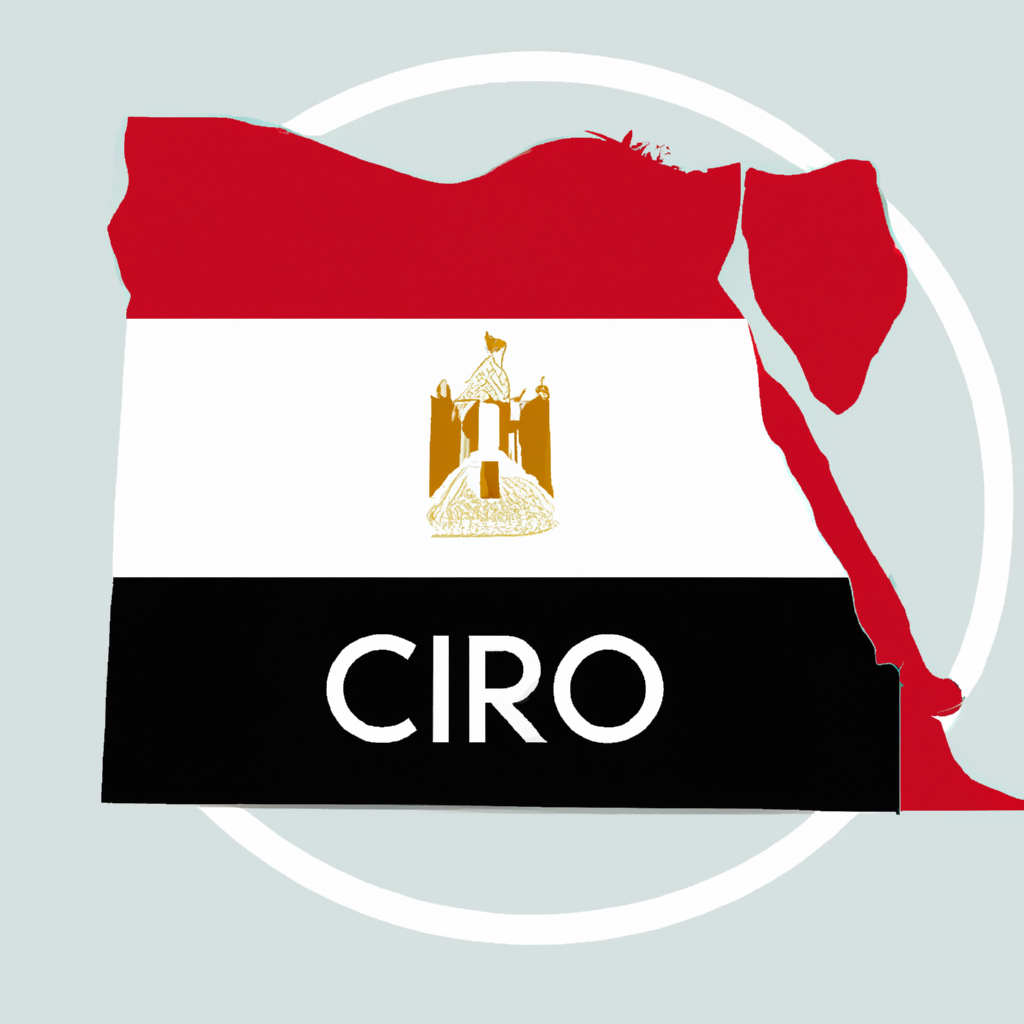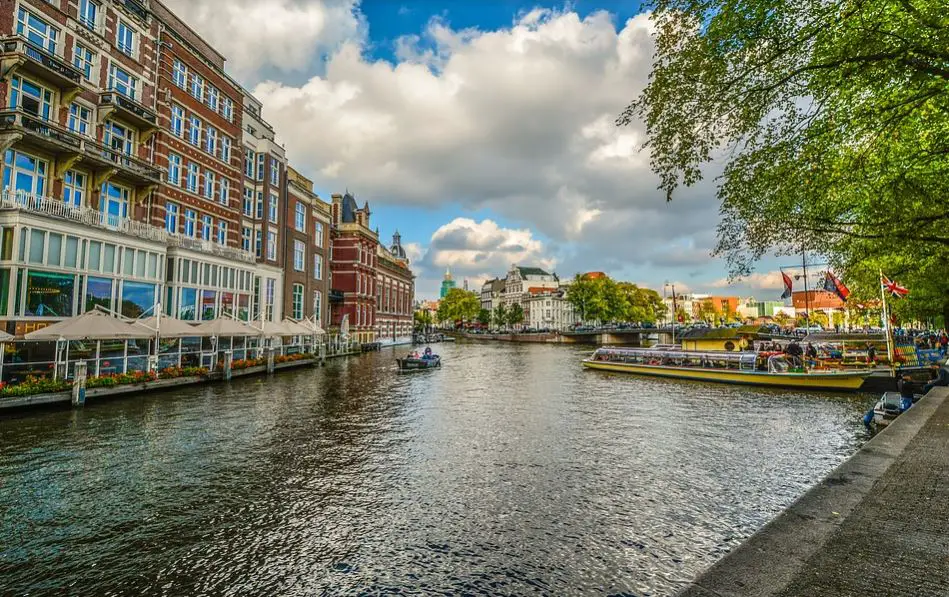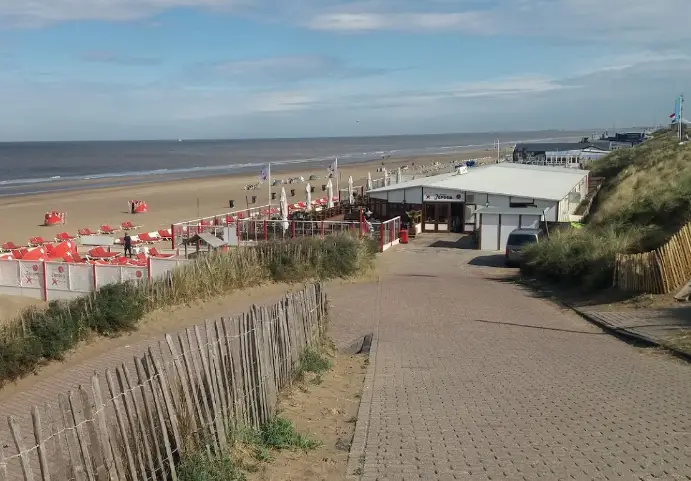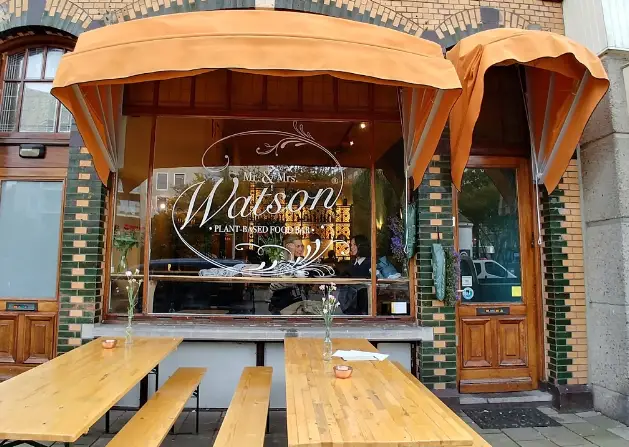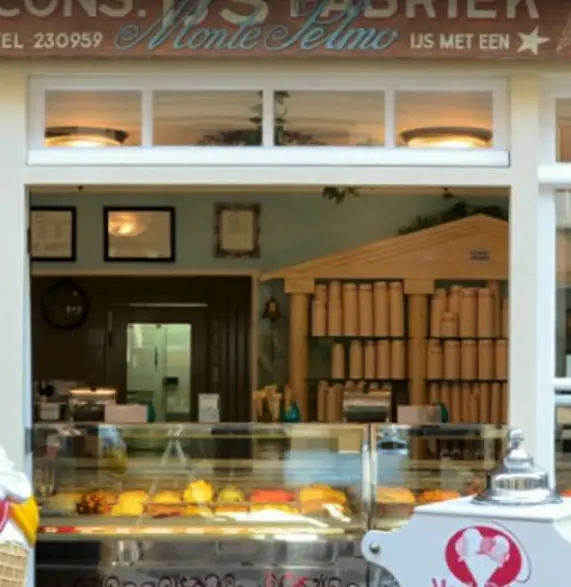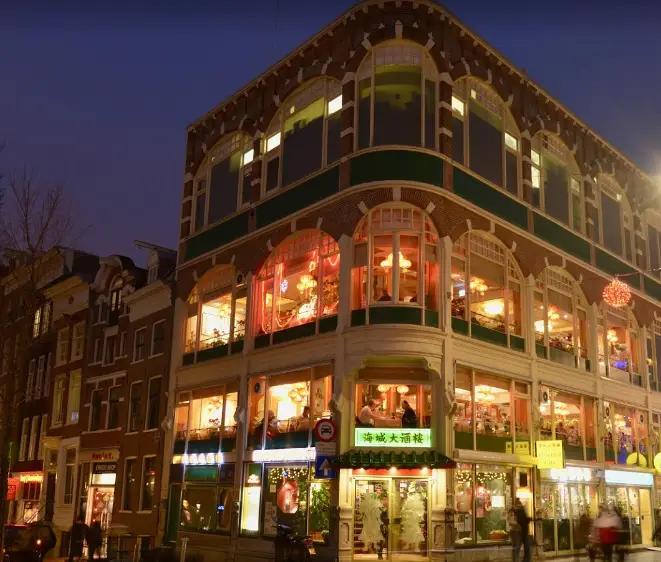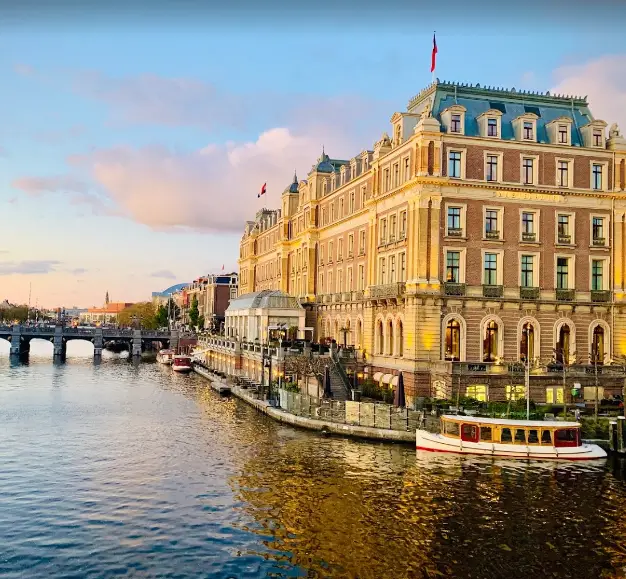Amsterdam, Netherlands: Interesting Facts,History, Things to do,Why to Visit
Post ByAdequate Travel
Amsterdam, the happening capital city of the Netherlands, is one of the most popular cities in Europe. With more than 25 million visitors annually, Amsterdam is a vibrant, buzzing metropolis alive with culture and life. From stunning historical sites, renowned galleries, and vibrant cafes to scenic canals and parks, Amsterdam offers something unique and special for everyone.The city’s interesting facts, history, and variety of things to do will leave your heart full and mind swollen. When you visit Amsterdam, you can explore its history, wander around the city’s unique architecture, or take a cruise on the canals – there’s no shortage of activities. From the vibrant nightlife and events to a wealth of historic sites, Amsterdam is a city that offers something for everyone. When you visit Amsterdam, you’ll truly understand why so many people from all around the world are drawn to it!
The Netherlands, also known as Holland, is a country located in Northwestern Europe. It is known for its flat landscape, extensive canal systems, tulip fields, windmills, and cycling routes. The country has a population of over 17 million people and is known for its liberal views on social issues such as euthanasia and same-sex marriage. The Netherlands is a constitutional monarchy with a parliamentary democracy and its capital city is Amsterdam. The country has a strong economy, driven by industries such as agriculture, manufacturing, and services. It is also a major global player in technology and innovation. The Netherlands is a founding member of the European Union and hosts several key international institutions, including the International Court of Justice and the International Criminal Court. The Dutch culture is rich in art, with notable contributions from painters such as Rembrandt and Van Gogh. The Netherlands is also known for its vibrant music scene, with electronic dance music being particularly popular.Discover the untold stories behind netherlands unique facts, and historical treasures.
Interesting facts
Interesting Facts about the Netherlands
1. Tulips:
Tulips are synonymous with the Netherlands and are one of the country's most iconic symbols. The Netherlands is the largest exporter of tulips in the world, with more than three billion bulbs being produced annually. The famous Keukenhof Gardens in Lisse showcases thousands of tulips each year and attracts millions of visitors.
2. Cycling Nation:
The Netherlands is known for its extensive network of cycling paths and is often referred to as the cycling capital of the world. Bicycles are a popular mode of transportation, with many Dutch people cycling to work, school, and for leisure. In fact, there are more bicycles than residents in the country!
3. Windmills:
Windmills are an integral part of Dutch landscape and history. Historically, windmills were used for various purposes such as grinding grains, draining water, and sawing timber. While most windmills are no longer operational, they remain a symbol of Dutch culture and can be seen across the countryside.
4. Dutch Cheese:
The Netherlands is renowned for its cheese production, particularly Gouda and Edam. Dutch cheese is exported worldwide and is enjoyed by cheese lovers all over. The country also hosts annual cheese markets, where traditional cheese trading and weighing practices are demonstrated.
5. UNESCO World Heritage Sites:
The Netherlands is home to an impressive number of UNESCO World Heritage Sites. Some notable examples include the historic canals of Amsterdam, the Beemster Polder (a reclaimed land area), and the Kinderdijk windmills, which collectively represent the country's rich cultural and natural heritage.
From museums to parks,netherlands tourist attractions offer something for everyone, making it a versatile destination for all type of tourists.Introduction
The Netherlands, also known as Holland, is a country located in Western Europe. It has a rich and diverse history that dates back centuries. From its renowned Golden Age to its role in world trade and influence, the Netherlands has played a significant part in shaping European history.Early History
The earliest inhabitants of the region that is now the Netherlands were Celtic and Germanic tribes. In the 1st century BC, the Romans conquered the area and established the province of Germania Inferior. Over time, the region experienced numerous invasions and migrations, including those by the Franks and the Vikings.The Golden Age
The 17th century is considered the Golden Age of the Netherlands. During this period, the Dutch economy thrived, fueled by trade, exploration, and colonialism. The Dutch East India Company and the West India Company played pivotal roles in expanding Dutch influence around the world. Dutch cities like Amsterdam, Rotterdam, and Utrecht became international centers for finance, shipping, and art.Colonial Empire
The Netherlands established a vast colonial empire during the Golden Age. Dutch traders and explorers ventured to distant lands, creating settlements and trading posts. The most notable colonies were in the East Indies (Indonesia), Suriname, the Netherlands Antilles, and parts of Africa, including South Africa. The Dutch influence can still be seen in many of these former colonies today.Independence and Monarchy
In 1581, the northern provinces of the Netherlands declared their independence from Spain, leading to the Eighty Years' War. The Dutch Republic, known as the United Provinces, emerged as a sovereign nation. In 1815, the Netherlands became a constitutional monarchy under King William I. The monarchy continues to exist today, with King Willem-Alexander as the reigning monarch.World Wars and Modern Era
The Netherlands faced significant challenges during the 20th century, particularly during the World Wars. The country remained neutral in World War I but was occupied by Nazi Germany during World War II. The Dutch Resistance played a crucial role in opposing the occupation, and Anne Frank's diary provided a moving account of this period. After the war, the Netherlands experienced rapid economic growth, becoming one of the wealthiest nations in the world.Conclusion
The history of the Netherlands is a tale of exploration, trade, colonization, and resilience. From its early tribal roots to its Golden Age and beyond, the Netherlands has left an indelible mark on European history. Today, it is known for its liberal social policies, innovative technology sector, and contributions to global culture.Exploring the rich heritage of historical sites in netherlands is a journey through time and culture.Famous Things in the Netherlands
1. Tulips:
Tulips are quintessentially Dutch and highly associated with the Netherlands. The country is famous for its stunning tulip fields, especially in spring. Keukenhof Gardens, located near Amsterdam, is one of the most popular destinations to witness the beauty of tulips in full bloom.
2. Windmills:
Windmills are an iconic symbol of the Netherlands and have played a crucial role in its history and culture. They were traditionally used for various purposes, such as pumping water out of low-lying areas, grinding grains, and sawing wood. The Kinderdijk area is particularly famous for its well-preserved windmills, which are now recognized as a UNESCO World Heritage site.
3. Cycling:
The Netherlands is known as the world's cycling capital, and cycling is deeply ingrained in Dutch culture. The country is famous for its extensive network of cycling paths and bike-friendly cities. Amsterdam, in particular, is renowned for its cycling culture, where bicycles outnumber cars in the city center.
4. Dutch Cheese:
The Netherlands is famous for its delicious cheeses, including Gouda and Edam. Dutch cheese markets, such as the one in Alkmaar, attract many tourists who come to taste and learn about the cheese-making process. Visitors can also explore cheese museums and shops across the country.
5. Van Gogh Museum:
The Van Gogh Museum, located in Amsterdam, houses the largest collection of works by the renowned Dutch painter Vincent van Gogh. It is a popular attraction for art enthusiasts worldwide, offering an in-depth look into the life and art of Van Gogh.
6. Rijksmuseum:
The Rijksmuseum is another famous museum in Amsterdam, dedicated to Dutch art and history. It showcases an extensive collection of artworks, including masterpieces by Dutch painters such as Rembrandt van Rijn and Johannes Vermeer.
7. Canals of Amsterdam:
The picturesque canals of Amsterdam are a UNESCO World Heritage site and a significant tourist attraction. Boat tours along the canals allow visitors to explore the city's charming waterways and admire the historic architecture lining the canals.
8. Dutch Delftware:
Delftware, or Delft Blue pottery, is a traditional blue and white ceramic pottery created in the city of Delft. It is highly regarded for its craftsmanship and intricate designs. Visitors can visit Delftware factories and shops to witness the production process and purchase unique pieces.
9. The Anne Frank House:
The Anne Frank House in Amsterdam is a significant historical site, where Anne Frank and her family hid from the Nazis during World War II. It is now a museum, offering a moving tribute to Anne Frank's life and the atrocities of the Holocaust.
10. Dutch Clogs:
Traditional wooden clogs, known as "klompen," are associated with the Netherlands. These iconic shoes have a long history and are still worn by some individuals, particularly in rural areas. Visitors can learn about the art of clog-making and purchase their own pair as a unique souvenir.
Discover some unique facts about netherlands that will leave you amaze and intrigue.Culture of the Netherlands
The culture of the Netherlands is influenced by its geography, history, and diverse population. It is known for its liberal values, multiculturalism, and a combination of traditional and modern elements.
Language
Dutch is the official language of the Netherlands. English is widely spoken and understood, especially in urban areas and among the younger generation. Other languages spoken in specific regions include Frisian, West Frisian, and Limburgish.
Art and Architecture
The Netherlands has a rich artistic history, particularly known for Dutch Golden Age painters like Rembrandt van Rijn and Johannes Vermeer. Dutch architecture showcases a mix of traditional and modern styles. Examples include the historic canal houses in Amsterdam and modern structures like the Eye Film Institute and Rotterdam's Markthal.
Food and Drink
The Dutch cuisine reflects its agricultural heritage and trade history. Traditional dishes include stamppot (a mashed potato and vegetable dish), haring (raw herring), and kroketten (deep-fried croquettes). Dutch cheese, such as Gouda and Edam, is internationally renowned. Dutch people also enjoy a good cup of coffee and have a strong coffee culture.
Cycling
The Netherlands is famous for its cycling culture. Bicycles are a common mode of transportation, with well-developed infrastructure including extensive networks of bike paths. Cycling is not only practical but also promotes a healthy and sustainable lifestyle.
Tolerance and Liberalism
The Netherlands has a long history of tolerance and liberal values. It was the first country to legalize same-sex marriage in 2001, and it is known for its LGBTQ+ rights. The country is also known for its open-mindedness and progressive policies, attracting diverse communities and cultures.
Festivals
The Netherlands hosts various cultural festivals throughout the year. King's Day, an annual national holiday on April 27th, is celebrated with street parties, live music, and flea markets. The Carnival in southern regions, the International Film Festival Rotterdam, and the Amsterdam Dance Event are other popular events.
Holidays and Traditions
The Netherlands celebrates traditional holidays such as Christmas, Easter, and New Year's Eve. Unique Dutch customs include Sinterklaas (St. Nicholas' Day), during which children receive gifts and enjoy parades. Tulip festivals and the Keukenhof Gardens showcase the Dutch love for flowers, particularly tulips.
Immerse yourself in the local culture by exploring netherlands's top-rated tourist attractions.Cuisine of the Netherlands
The cuisine of the Netherlands, also known as Dutch cuisine, is influenced by its proximity to other European countries and its rich agricultural resources. It is known for its hearty, simple, and traditional dishes that are often made using locally sourced ingredients.
Characteristics of Dutch Cuisine
1. Variety of Dairy Products: Dairy plays a major role in Dutch cuisine, and the Netherlands is famous for its high-quality dairy products such as cheese, milk, and butter. Dutch cheeses like Gouda and Edam are popular worldwide.
2. Seafood: Given its location, seafood is also an important part of Dutch cuisine. Herring, mackerel, eel, and shrimp are commonly found in traditional dishes.
3. Potatoes: Potatoes are a staple in Dutch meals. They are often served as fries (patat) or mashed potatoes (stamppot) and are accompanied by various toppings or meats such as beef or sausages.
4. Stroopwafels: Stroopwafels are a well-known Dutch treat. They are thin, waffle-like cookies with a layer of caramel syrup in the middle.
Traditional Dutch Dishes
1. Stamppot: Stamppot is a classic Dutch comfort food made by mashing together potatoes and vegetables such as kale or sauerkraut. It is often served with smoked sausage (rookworst).
2. Bitterballen: Bitterballen are savory deep-fried meatballs filled with a mixture of beef or veal ragout. They are a popular snack often enjoyed with a drink at bars or parties.
3. Poffertjes: Poffertjes are small, fluffy pancakes typically served with butter and powdered sugar. They are a popular street food in the Netherlands.
4. Erwtensoep: Erwtensoep, also known as Dutch pea soup, is a thick and hearty soup made with split peas, vegetables, and often includes smoked sausage or bacon.
Influence of Other Cultures
Due to its history of trade and colonization, Dutch cuisine has been influenced by various cultures. For example:
1. Indonesian Influence: The Netherlands once had colonies in Indonesia, which has led to the incorporation of Indonesian flavors and dishes into Dutch cuisine. Indonesian-influenced dishes such as nasi goreng (fried rice) and satay (grilled skewered meat) are quite popular.
2. Surinamese Influence: Suriname, a former Dutch colony in South America, has also contributed to the diversity of Dutch cuisine. Dishes like roti (Indian flatbread with curried meat or vegetables) and pom (oven-baked dish with chicken, pomtajer, and spices) have become part of the Dutch culinary landscape.
3. Middle Eastern Influence: In recent years, Middle Eastern cuisine has gained popularity in the Netherlands, with various kebabs, falafel, and hummus becoming more commonly found in Dutch cities.
In conclusion, the cuisine of the Netherlands showcases a blend of traditional Dutch dishes and influences from other cultures. With its emphasis on dairy products, seafood, potatoes, and beloved treats like stroopwafels, Dutch cuisine offers a range of flavors and comfort foods that reflect the country's culinary heritage.Discover unique facts about netherlands, a destination filled with rich history and natural beauty.1. Explore Amsterdam
Amsterdam is a vibrant and picturesque city with numerous attractions to explore. Visit the famous Anne Frank House to learn about the history of World War II, tour the Van Gogh Museum to admire his masterpieces, or take a relaxing boat cruise along the iconic canals. Don't forget to visit the lively Dam Square and the beautiful Vondelpark.
2. Visit the Keukenhof Gardens
The Keukenhof Gardens, located near Lisse, is one of the most stunning floral displays in the world. With over seven million flowers planted annually, it is a paradise for nature lovers and photographers. Take a leisurely stroll through the colorful tulip fields, enjoy the stunning flower shows, and immerse yourself in the fragrant atmosphere.
3. Explore the Kinderdijk Windmills
Kinderdijk is a UNESCO World Heritage site known for its iconic windmills. Take a bicycle tour or boat ride to explore this scenic area and learn about the history and use of these traditional windmills, which were originally used for water management. Marvel at the beautiful landscapes and capture some incredible photographs.
4. Visit the Rijksmuseum in Amsterdam
The Rijksmuseum is one of the most important art museums in the Netherlands, featuring a vast collection of Dutch masterpieces from the Golden Age. Admire Rembrandt's "The Night Watch," Johannes Vermeer's "The Milkmaid," and other renowned works of art that provide insights into Dutch culture and history.
5. Explore The Hague
The Hague, the political capital of the Netherlands, offers a rich blend of history, culture, and stunning architecture. Visit the Mauritshuis museum, home to Vermeer's "Girl with a Pearl Earring," and explore the beautiful Binnenhof complex, which houses the Dutch parliament. Don't miss The Hague's stunning beaches, such as Scheveningen, which are perfect for relaxation and enjoyment.
6. Discover the Hoge Veluwe National Park
The Hoge Veluwe is the largest national park in the Netherlands and offers a diverse landscape of forests, heathlands, and sand dunes. Explore the park's extensive network of hiking and cycling trails, visit the Kröller-Müller Museum with its impressive collection of art, and spot wildlife such as deer and wild boar in their natural habitat.
7. Enjoy the Canals of Utrecht
Utrecht, often called "Little Amsterdam," boasts beautiful canals and charming medieval architecture. Take a boat tour along the canals to admire the city's unique character, visit the Dom Tower for panoramic views, and explore the lively street cafés, boutique shops, and vibrant nightlife.
8. Visit the Windmills at Zaanse Schans
Zaanse Schans is a picturesque open-air museum near Amsterdam, famous for its well-preserved windmills, wooden houses, and traditional Dutch craftsmanship. Take a guided tour to learn about the history of these windmills and see them in action, discover traditional cheese-making techniques, and shop for authentic souvenirs.
9. Explore the Frisian Islands
The Frisian Islands, located in the northern part of the Netherlands, offer beautiful sandy beaches, dunes, and peaceful landscapes. Take a ferry to one of the islands, such as Texel or Terschelling, and enjoy outdoor activities like cycling, hiking, and bird-watching. Discover charming coastal villages, try traditional seafood dishes, and relax in the tranquil surroundings.
10. Visit the Delta Works
The Delta Works is an impressive system of dams, barriers, and storm surge barriers designed to protect the Netherlands from flooding. Visit the Neeltje Jans exhibit to learn about the construction and importance of these engineering marvels. Take a guided tour to understand the country's battle against water and witness the sheer scale of these protective structures.
When planning your trip to netherlands, be sure to include the best things to do in netherlands, which encompass a wide range of cultural experiences.Climate of the Netherlands
The climate of the Netherlands is categorized as a temperate maritime climate, influenced by the North Sea and the Atlantic Ocean. It is characterized by mild summers and cool winters, with rainfall distributed fairly evenly throughout the year. Below are some key points about the climate of the Netherlands:
Seasonal Temperatures:
- The average temperature in the summer months (June to August) ranges from 17°C to 20°C (63°F to 68°F).- In the winter months (December to February), average temperatures range from 2°C to 6°C (35°F to 43°F).Rainfall and Precipitation:
- The Netherlands has a moderate level of rainfall, with an average of 700 to 900 millimeters (28 to 35 inches) per year.- Rainfall is relatively evenly distributed throughout the year, although the autumn months (September to November) tend to have slightly higher precipitation.- The country experiences occasional periods of heavy rainfall, particularly during the summer months.Wind and Storms:
- The Netherlands is known for its strong winds, especially along the coastal regions.- The prevailing westerly winds from the Atlantic Ocean can bring in storms and gales, particularly during the winter months.- The country has also implemented innovative engineering solutions, such as dikes and sea barriers, to protect against storm surges and flooding.Climate Change:
- Like many other regions, the Netherlands is also experiencing the effects of climate change, such as rising sea levels and more extreme weather events.- The Dutch government has been actively implementing measures to mitigate and adapt to climate change, including sustainable water management and renewable energy initiatives.Overall, the climate of the Netherlands is moderate and influenced by its proximity to the North Sea and Atlantic Ocean. The country experiences mild summers, cool winters, and a relatively even distribution of rainfall throughout the year. However, it is important to note that climate change is impacting the region, necessitating measures to address the associated challenges.Uncover the best netherlands attractions that will leave you awe-inspired and wanting more.Popular Activities in the Netherlands
Cycling
One of the most popular activities in the Netherlands is cycling. The country is known for its extensive network of cycling paths and well-developed infrastructure for bicycles. Dutch people use bicycles for various purposes, including commuting to work, running errands, and leisurely rides. Visitors can rent bikes and explore the beautiful countryside, coastal areas, and charming cities. Popular cycling destinations include Amsterdam, Rotterdam, The Hague, and the picturesque countryside of North Brabant and Limburg.Visiting Museums
The Netherlands is home to a rich cultural heritage, and it is renowned for its museums. Amsterdam alone boasts some of the most famous museums in the world, including the Van Gogh Museum, Rijksmuseum, and Anne Frank House. Visitors can explore the impressive art collections, learn about Dutch history, and immerse themselves in various exhibitions. Other notable museums in the Netherlands include the Mauritshuis in The Hague, Kröller-Müller Museum in Hoge Veluwe National Park, and the Zuiderzee Museum in Enkhuizen.Exploring Tulip Fields
The Netherlands is famous for its vibrant tulip fields, particularly during the spring season. Keukenhof, located near Lisse, is one of the largest flower gardens in the world and is a must-visit attraction. Visitors can stroll through the meticulously landscaped gardens and admire millions of tulips, daffodils, and other colorful flowers. The Bloemen Route (Flower Route) is a popular driving or cycling route that takes you through scenic flower fields and picturesque villages.Boat Cruises
With its extensive canal system and proximity to the North Sea, the Netherlands offers numerous opportunities for boat cruises. Visitors can explore Amsterdam's famous canals — a UNESCO World Heritage site — on a scenic canal tour. In addition, there are boat cruises available in cities such as Utrecht, Leiden, and Rotterdam, offering a unique perspective of the Dutch architecture and cityscapes. The Wadden Sea, a UNESCO-listed natural reserve, is another popular destination for boat tours, where visitors can spot seals, birds, and unique marine life.Visiting Windmills
Windmills are iconic symbols of the Netherlands, and exploring them is a popular activity. Kinderdijk, a UNESCO World Heritage site near Rotterdam, is known for its 19 well-preserved windmills. Visitors can take a guided tour, learn about the history of windmills, and even enter some of them to see the mechanisms inside. Zaanse Schans, located near Amsterdam, is another picturesque spot with a collection of traditional windmills, as well as traditional houses, shops, and museums.These are just a few examples of the popular activities in the Netherlands. The country has a lot to offer in terms of cultural experiences, outdoor adventures, and historical sites, ensuring a diverse range of options for visitors to enjoy.Plan your trip with a list of the best things to do in netherlands, catering to all interests.Night Life in the Netherlands
The Netherlands offers a vibrant and diverse nightlife scene, with options to suit all interests and preferences. Whether you are looking for bustling clubs, cozy pubs, live music venues, or cultural experiences, there is something for everyone to enjoy after dark. Here are some highlights of the night life in the Netherlands:
1. Amsterdam
Amsterdam is famous for its legendary nightlife, attracting visitors from all around the world. The city boasts numerous bars, clubs, and music venues catering to a variety of tastes. The famous Red Light District is a popular hotspot, with its array of bars, clubs, and adult entertainment establishments. Alternatively, the Leidseplein and Rembrandtplein squares offer a more eclectic mix of venues, including live music bars, cocktail lounges, and nightclubs.
2. Rotterdam
Rotterdam is another city known for its thriving nightlife. The Witte de Withstraat is a trendy street lined with bars, restaurants, and clubs, attracting locals and tourists alike. The city also offers a range of cultural experiences, such as theater performances and live music events. In the summer months, various outdoor festivals and concerts take place, providing unique opportunities to enjoy the night outdoors.
3. The Hague
The Hague may be famous for its governmental institutions, but it also offers a vibrant nightlife scene. The center of the city is filled with bars, pubs, and clubs catering to different tastes and age groups. The Plein and Grote Markt squares are known for their bustling nightlife, with plenty of options for those seeking a lively evening out.
4. Utrecht
Utrecht, a charming city with its beautiful canals and historic buildings, also offers a lively nightlife. The city center is home to numerous bars and cafes, especially around the Oudegracht canal. In addition to the bustling nightlife, Utrecht hosts various music festivals and events throughout the year, showcasing both local and international talent.
5. Eindhoven
Eindhoven is a city known for its technological innovations, but it doesn't fall short when it comes to nightlife. The Stratumseind is a street packed with bars, clubs, and restaurants that stay open late into the night. The city also hosts regular music festivals and events, ensuring there is always something happening after dark.
6. Cultural Experiences
Aside from the traditional nightlife scene, the Netherlands offers unique cultural experiences after hours. Amsterdam's Concertgebouw and Rotterdam's De Doelen are renowned concert halls that host classical music performances, while various theaters across the country put on plays, musicals, and dance shows. Additionally, museums like the Van Gogh Museum and the Rijksmuseum in Amsterdam often host evening events, providing a different perspective on the country's rich culture.
Overall, the Netherlands provides a diverse and exciting nightlife experience, with cities like Amsterdam, Rotterdam, The Hague, Utrecht, and Eindhoven offering a wide range of options for party-goers, music enthusiasts, and those seeking cultural experiences. From lively clubs to cozy pubs, live performances to cultural events, there is something for everyone to enjoy after dark in the Netherlands.Discover unique facts about netherlands, a destination filled with rich history and natural beauty.Reasons to Visit the Netherlands
1. Rich History and Culture: The Netherlands offers a wealth of historical and cultural treasures for visitors to explore. From its picturesque windmills, charming canals, and medieval towns like Amsterdam and Utrecht, to its world-class museums, such as the Anne Frank House and the Rijksmuseum, the country is a haven for history enthusiasts. For example, visitors can explore the beautiful tulip fields during spring, witness traditional Dutch architecture, or visit historic sites like the Royal Palace in Amsterdam.
2. Breathtaking Natural Landscapes: The Netherlands boasts stunning natural landscapes that are worth exploring. The country is famous for its flat terrain and is home to several impressive national parks, such as Hoge Veluwe National Park and De Biesbosch. These parks offer diverse flora and fauna, perfect for hiking, biking, or simply enjoying peaceful walks in serene surroundings.
3. Bicycle-Friendly Culture: The Netherlands is renowned for its bicycle-friendly culture and infrastructure. With an extensive network of cycle paths and bike rental options, visitors can easily explore cities and countryside on two wheels. This offers a unique and environmentally-friendly way to discover the country, allowing visitors to immerse themselves in the local lifestyle and enjoy breathtaking scenery.
4. World-Class Museums: The Netherlands houses some of the finest museums in the world, making it an ideal destination for art and culture lovers. The Van Gogh Museum in Amsterdam showcases the works of the famous Dutch painter, Vincent van Gogh. Additionally, the Mauritshuis in The Hague is renowned for its collection of Dutch Golden Age masterpieces, including Vermeer's "Girl with a Pearl Earring." These museums provide an enriching experience for art enthusiasts and history buffs.
5. Vibrant Cities: The Netherlands is home to vibrant and cosmopolitan cities that offer a unique blend of old-world charm and modernity. Amsterdam, the capital city, is famous for its picturesque canal network, world-class nightlife, and diverse cultural scene. Rotterdam is known for its modern architecture, with highlights like the futuristic Cube Houses and the iconic Market Hall. Other cities like Utrecht and The Hague also have their distinctive charm and offer plenty of attractions and activities for visitors to enjoy.
In conclusion, the Netherlands offers a variety of compelling reasons to visit. Its rich history and culture, breathtaking natural landscapes, bicycle-friendly culture, world-class museums, and vibrant cities make it a captivating destination for travelers. Whether you're interested in exploring historical sites, immersing yourself in nature, or experiencing lively city life, the Netherlands has something to offer for everyone.Whether you're a history buff or an adventure seeker, netherlands has an attraction for you. So, don't miss the chance to visit popular places in netherlandsNumber of Days Required to Visit Netherlands
There is no fixed number of days required to visit the Netherlands as it depends on various factors such as your travel preferences, interests, and the places you wish to explore. However, to get a comprehensive experience of the country, it is recommended to spend at least 7-10 days.
Factors Affecting the Duration of Visit
1. Places to Visit: The Netherlands offers a plethora of attractions, including Amsterdam, Rotterdam, The Hague, Utrecht, and various quaint villages and countryside. The number of days required will depend on how many of these places you plan to visit.
Example: If you plan to visit only Amsterdam, you can comfortably explore the city in 3-4 days. However, if you also want to visit other major cities and towns, you will need more time.
2. Interests: The duration of your stay also depends on your interests. If you are interested in art, museums, and history, you may need extra time to thoroughly explore the famous museums and cultural sites in the country.
Example: If you are an art enthusiast and plan to visit the Van Gogh Museum, Rijksmuseum, and other art galleries, you might need a few additional days to appreciate these attractions fully.
3. Day Trips: The Netherlands offers several exciting day trip options to nearby towns and attractions. If you wish to include day trips in your itinerary, you will need additional days to accommodate those.
Example: If you want to explore the windmills at Kinderdijk or go on a boat tour in Giethoorn, you should allocate a day or two for such activities.
4. Pace of Travel: Some travelers prefer to take things slow and spend more time in each destination, while others may be content with quick visits and covering multiple places in a short time. Your preferred pace of travel will also influence the number of days you require.
Example: If you want to experience the laid-back atmosphere of the Dutch countryside or spend leisurely hours in canal-side cafes, you might want to extend your stay compared to those who prefer a fast-paced city tour.
Overall, it is advisable to plan your itinerary well in advance, considering the factors mentioned above and allowing for some flexibility. This will ensure you have enough time to explore the Netherlands and make the most out of your trip.
Step back in time as you visit the historical sites in netherlands, where the past comes alive.Significance of the Netherlands
The Netherlands holds significant importance in various aspects, ranging from its geography and economy to its cultural heritage. Here are some key points that highlight the significance of the Netherlands:
